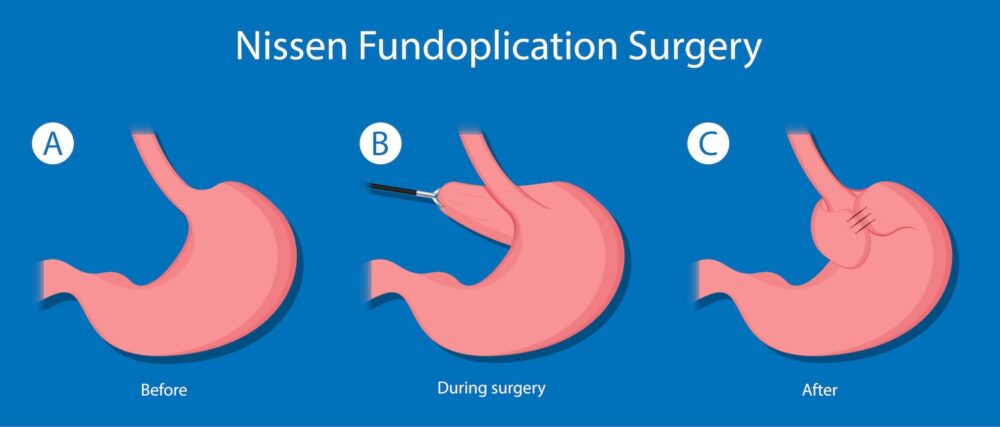Complete Fundoplication
Gastroesophageal reflux disease (GERD) is a chronic condition where the stomach contents reflux into the esophagus. This backwards flow occurs when stomach contents reflux and enter the lower end of the esophagus due to a relaxed or weakened lower esophageal sphincter (LES). GERD is treatable disease and serious complications may occur if left untreated.
The surgical technique used to treat GERD is called fundoplication, and there are different kinds. The Nissen fundoplication is a 360 degree posterior wrap of the fundus of the stomach around the lower esophagus. The Toupet fundoplication is a partial wrap – 270 degree posterior wrap around the lower esophagus. Nissen Fundoplication surgery (also called complete fundoplication) is a procedure that can successfully treat GERD by correcting the problem at its root cause.
Normally, the stomach contents do not enter the esophagus (food pipe) because the lower esophageal sphincter holds this lower end of the pipe closed. When GERD is a problem, the LES becomes weakened or relaxed, enabling stomach acids to travel up into the esophagus.
Schedule An Appointment
What Is Nissen Fundoplication Surgery?
The Nissen fundoplication (fundo) surgical technique strengthens the lower esophageal sphincter (LES). When performing a fundoplication, the fundus of the stomach (the part of the stomach that is closest to the entry of the esophagus) is gathered, wrapped, and sutured in place around the lower end of the esophagus and the sphincter. This surgery may be performed through a large, open abdominal incision or endoscopically, through 5 smaller incisions.
Nissen Fundoplication Procedure
Nissen Fundoplication is performed under general anesthesia. The procedure may be done as day surgery either in the hospital or outpatient surgery centers.
For a laparoscopic Nissen Fundoplication procedure, the surgeon uses a needle to inject a harmless gas into the abdominal cavity near the belly button. This expands the viewing area of the abdomen, providing a clear view and room to work. The surgeon makes a small incision in the upper abdomen and inserts a tube called a trocar through which the laparoscope (a viewing tube with a camera) is introduced into the abdomen. Additional small incisions will be made for the surgical instruments to be used during the procedure.

- With the images from the laparoscope as a guide, your surgeon wraps the upper part of the stomach, the fundus, around the lower esophagus to create a valve, suturing it in place.
- The hole in the diaphragm through which the esophagus passes is then tightened with sutures.
- The laparoscope and other instruments are removed and the gas released.
- The tiny incisions are closed and covered with small bandages.
Laparoscopy is much less traumatic to the muscles and soft tissues than the traditional method of surgically opening the abdomen with long incisions (open techniques). While this procedure has advantages and disadvantages as compared to Toupet Fundoplication, patients who undergo Nissen Fundoplication report more objective and subjective reflux control over 1 year.
Post-Operative Guidelines
After surgery, your surgeon will give you guidelines to follow. Common post-operative guidelines following laparoscopy include the following:
- Someone must drive you home after you are released because the anesthesia may make you feel groggy and tired.
- Do not remove the dressings over the incisions for the first two days and keep the area clean and dry. No showering or bathing during this time. The incisions usually heal in about 5 days.
- Your surgeon may give you diet and activity restrictions. It is very important that you follow your surgeon’s instructions for a successful recovery.
- You may feel soreness around the incision areas. Your surgeon may give you a prescription pain medicine or recommend NSAID’s (non-steroidal anti-inflammatory drugs) for the first few days to keep you comfortable.
- If the abdomen was distended with gas, you may experience discomfort in the abdomen, chest, or shoulder area for a couple days while the excess gas is being absorbed.
- Contact your doctor immediately if you have a fever, chills, increased pain, bleeding or fluid leakage from the incisions, chest pain, and shortness of breath, leg pain, or dizziness.
Risks & Complications of Nissen Procedure
As with any surgery there are potential risks involved. Specific complications for Nissen Fundoplication include:
- Post-operative fever and infection
- Surgical injury to blood vessels
- Surgical injury to stomach or esophagus
- Swallowing difficulties
- Gas embolism
- Adhesions – Extensive scar tissue formation can form in the surgical area.
- Repeat Surgery – Sometimes the new valve weakens or loosens months or years after the surgery causing symptoms again. If symptoms are severe, the surgery may need to be repeated.
Nissen Fundoplication Procedure in North Texas
Contact Dr. Malladi and her experienced North Texas team to learn more about the GERD treatments available or to schedule an appointment at either the Dallas or Plano clinic location.
